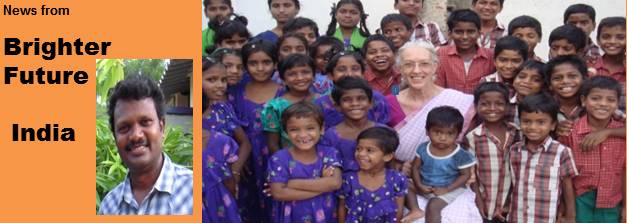| In 2013 the rally was a candlelight one. |
Each year a rally is held in the town centre to highlight the government's work to decrease the numbers of people infected with HIV/AIDS. Groups of nurses, scouts, police cadets and other youth groups walk with banners through the town and end up at a venue where government staff make speeches. As Brighter Future is the only organisation that cares for Children with HIV/AIDS they are invited to send children to attend the rally. A day off school and a walk around Vizianagaram may be exciting but waiting around and listening to speeches is very boring for the children. A bag of water and a few biscuits is not much compensation!
| Victor and senior boys at the 2014 Rally |
The good news is that new HIV/Aids infections in India have declined by 50% since 2007. A UN report estimates that there are now 2.9 million cases in India, making it third in world ranking, behind South Africa and Nigeria. The total population of India is over 1200 million so the percentage of people with HIV/AIDS is only 4%.
| and Laxmi nurse and some girls were there too! |
The government's National policy started with awareness and condom distruibution and went on to target sections of the population like sex workers and lorry drivers. The emphasis is now concentrating on treatment and the prevention of passing the virus through childbirth and breast feeding. Centres and sub centres for testing have been opened in large urban areas. The north eastern states and south India have the greatest number of cases.. The north eastern distribution, bordering Nepal, Burma, and Thailand is assosiated with intravenous drug use.
In southern India the spread of the virus is associated with low literacy, and migratiory labour. and men having sex with men. The numbers of female sex workers with HIV has fallen from 10.1% to 2.7%.
There are 70,000 people receiving ART (anti retroviral therapy) in India - the largest in any single country.but treatment coverage is only 36 %, whereas 51 per cent of deaths are AIDS related
Officially
New cases continue to decline. but Brighter Future knows from it's
experience, working in three districts among a total popultion of 7 million,
that many cases are not registered because of lack of awareness and stigma
while deaths go unrecorded or are mis-recorded.
The
HIV-Aids budget is only 5% of the health budget as India has other pressing
needs like malaria, diabetes, heart disease and TB to deal with.Recently there
were drug shortages. ( see blog of 11th Sept 2014). Also the threshold at which
treatment should be started is lowered from the WHO recommended 500 to 300 and
in some parts of our area, to 200, meaning that people are more sick when they
start treatment. They have more problems adjusting to the drugs and they are
more susceptible to side effects and open to other diseases like TB. Are
these mismanagement, infrastructure or money saving isuses?
A new law is before the Indian parliament to outlaw discrimination but there is the likelihood that the laws will not be enforced. Our children have bus passes to get tothe hospital for blood tests but the bus conductors will not accept them or only give 1 rupee off instead of half fare. Our Narasannapeta patients who have been given a bus pass don't use it because the conductor will announce that the holder is HIV+ to the whole bus. Brighter Future have complained in vain to the bus companies! This year, however, Indian Railways have included a concession for HIV+ patients by labelling them as 'Immuno- suppressed' and grouping them with cancer patients.
